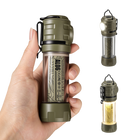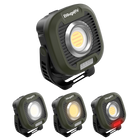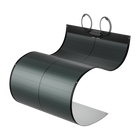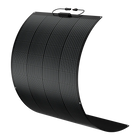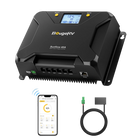Can A Portable Power Station Run A Refrigerator?


Are you tired of being tied down to your home's electrical outlets when you want to use your refrigerator for outdoor events or camping trips? The solution may lie in a portable power station. But can a portable power station run a refrigerator? The fast answer is yes, but it depends on the power station's inverter output and surge capacity.
Let's explore more about the capabilities of portable power stations and whether they can handle the energy requirements of a typical refrigerator.
What Is A Portable Power Station?
A portable power station (PPS) is a device that stores electrical energy, usually in the form of a battery. It can be used to power various electronic devices and appliances such as laptops, phones, fridges, etc.
Portable power stations are becoming increasingly popular as people look for ways to stay connected and keep their devices charged while on the go, whether camping in the wilderness or working remotely from a park.
A portable power station typically includes internal batteries, an inverter, and a charge controller.
- The battery stores the energy. It’s measured in watt-hours (Wh) and determines how much power the power station can store. The larger the battery capacity, the longer the power station can provide electricity to devices.
- The inverter converts the DC (direct current) power from the battery into AC (alternating current) power that household devices can use. The output power of the inverter is measured in watts (W). It determines how much power the power station can deliver to devices at any given time.
- And the charge controller manages the charging of the battery, ensuring that it is charged efficiently and safely. It can also regulate the input voltage from the solar panels or other charging sources, preventing the battery from overcharging or discharging too quickly.
There’re power stations from BougeRV that can run a refrigerator and other electronics and appliances. Featuring high inverter output, they can handle most refrigerators' power demands without any issues.
Additionally, the high surge capacity ensures that they can handle your refrigerator with start-up power requirements, without shutting down. Equipped with multiple outlets, BougeRV’s portable can also power a wide array of devices at the same time.
How Does A Portable Power Station Work?
In terms of how a portable power station works, it's quite simple.
When the power station is plugged into a charging source, such as a wall outlet or solar panel, the charge controller regulates the charging process to ensure the internal battery is charged safely and efficiently. Once the battery is fully charged, the power station is ready to be used.
While plugging a fridge or other devices into the power station, the inverter converts the DC power from the battery into AC power that the fridge can use. The amount of power delivered to the fridge depends on the inverter's output power and the battery's capacity.
In short, the portable power station is a device featuring a built-in energy inverter, which can turn the power of an internal battery into AC power that can be used to run your fridge, phones, laptops, etc., individually or simultaneously— given that the power station has the proper capacity and watt-hours.
Can A Portable Power Station Run A Refrigerator?
Now, let's look more deeply at what a portable power station will need to satisfy the energy demands of an average refrigerator.
It's crucial to understand the power requirements of a refrigerator. A typical household refrigerator requires a continuous power supply of around 100 to 200 watts. However, this wattage can spike up to 600-800 watts during startup, which is known as surge capacity. The surge capacity is required to kick-start the compressor motor of the refrigerator.
Now let's look at a typical portable power station's capability. Portable power stations come with different battery capacities and inverter output power.
For a portable power station to run a refrigerator, it must have a high enough battery capacity and inverter output power to handle the refrigerator's startup surge and continuous power requirements. To ensure that your portable power station is capable of running a refrigerator, check its specifications for the following:
-
Battery Capacity - A portable power station with a battery capacity of at least 500Wh is recommended to handle the energy requirements of a refrigerator.
-
Inverter Output Power - A portable power station with an inverter output power of at least 500W continuous and 1000W surge is recommended to handle the startup surge of a refrigerator.
It's important to note that the actual runtime of a portable power station powering a refrigerator will depend on several elements, including the size and efficiency of the fridge, the ambient temperature, and how often the refrigerator is opened and closed.
In conclusion, a portable power station can run a refrigerator if it has a high enough battery capacity and inverter output power to handle the refrigerator's startup surge and continuous power requirements. When choosing a portable power station, it's essential to check its specifications carefully to ensure it can meet your power needs.
What Size Power Station Do I Need For A Refrigerator?
Choosing the right portable power station size for your refrigerator can be confusing.
Still, it's essential to get it right to avoid disappointment and frustration later on. Understand that the size of the power station you need for your refrigerator will depend on a few factors, including the size and efficiency of your refrigerator, the ambient temperature, and how often the refrigerator is opened and closed.
However, as a general law of thumb, a portable power station with a battery capacity (BC) of at least 500Wh, an inverter output power of at least 500W continuous, and a 1000W surge is recommended for most standard refrigerators.
Here's a quick reference table to help you determine what size power station you need for your refrigerator:
|
Refrigerator Size |
Battery Capacity |
Inverter Output Power |
|---|---|---|
|
Mini Fridge |
150-300Wh |
100-200W continuous, 300-400W surge |
|
Compact Fridge |
300-500Wh |
200-300W continuous, 500-800W surge |
|
Standard Fridge |
500-1000Wh |
500W continuous, 1000W surge |
Always check the specifications of your refrigerator and portable power station carefully to ensure that you have sufficient power to meet your needs.
How To Power A Portable Fridge With A Portable Power Station?

Suppose you plan to go on a camping trip or a road trip. In that case, powering a portable fridge is crucial to your preparations. Let's examine how to power a portable fridge and chill your food and beverages.
Step 1: Choose the right power source
The first step in powering a portable fridge is to choose the right power source. A portable power station makes you essential appliances like a fridge keep running when in a power outage or off-grid while enjoying your fridge, air conditioning, or TV. BougeRV portable power stations offer a useful range of power ratings, with clear screens that display how long your PPS will last. With various outputs, they can even charge your multiple devices at the same time.
Step 2: Determine the power consumption of your fridge
The next step is to determine the power consumption of your fridge. This information can usually be found in the fridge's manual or on the manufacturer's website. Choosing a power source that can provide enough power to run the fridge without draining the battery too quickly is important.
On average, a small portable fridge uses from 40 to 65 watts. But some models use less than that while larger models can use up to 100 watts or more. It's crucial to note that these figures might vary based on the manufacturer and model of the refrigerator, as well as other aspects like the type of compressor utilized and the insulation's efficiency.
Step 3: Connect the power source to the fridge
Once you have chosen the right portable power station and determined the power consumption of your fridge, it's time to connect the two. But note the portable power station should be situated in a secure location with adequate ventilation.
Step 4: Monitor the power usage
It's important to monitor the power usage of your portable fridge to ensure that it doesn't drain the battery too quickly. Some portable fridges come with a built-in battery monitor. Still, if your fridge doesn't have one, you can use a multimeter to measure the battery's voltage.
Step 5: Maintain the power source
To ensure that your power source continues to provide enough power to run your fridge, it's important to maintain it properly. This includes keeping your battery charged and following the manufacturer's detailed instructions.
What Size Power Station Do I Need For A 12V Refrigerator?

To determine the power station size, you need for your 12V refrigerator, you'll need to know its power consumption in watts. This information can usually be found on the manufacturer's website or in the owner's manual.
Once you have this information, you can use the following example calculation:
Let's say you have a 12V refrigerator that consumes 50 watts per hour and want to keep it running for 24 hours.
That means you'll need a power station with a capacity of at least 1,200 WH(50 watts x 24 hours = 1,200 WH).
However, it's vital to note that this is just a rough estimate. You may need a larger power station if your refrigerator has a higher power consumption or if you plan on using other devices simultaneously. It's always a great idea to err on the side of caution and choose a power station with a higher capacity than you think you'll need.
How To Choose A Portable Power Station?
It might be challenging to decide on the ideal portable power station with so many possible options. Let us help you choose a portable power station that suits your demands and budget without making you second-guess your purchase.
-
Determine Your Power Needs: Consider what devices you need to power, including the wattage and runtime of each device. Calculate the total wattage and runtime for all your devices to determine the minimum wattage and capacity of the power station you need.
-
Consider the Battery Type: Portable power stations have various types of batteries, including lithium-ion, lead-acid, and nickel-cadmium.
Lithium-ion batteries are the best power-to-weight ratio which charges faster and last longer. BougeRV has portable power stations equipped with premium lifepo4 batteries, the subtype of the lithium-ion batteries, promoting the lifespan(up to 3500+ cycles life), safety, and optimal heat range of off-grid energy solutions!
In contrast, lead-acid batteries are heavier but less expensive. Nickel-cadmium batteries are rare and not recommended for portable power stations.
-
Look at the Capacity: When choosing a portable power station for a fridge, you need to consider the fridge's power requirements, usually measured in watts. Most fridges, from mini to big middle ones, can consume between 35 to 70 watts, but some high-end models may require more.
To calculate the power station capacity needed to run a fridge, you need to estimate how long you want the fridge to run, the fridge's power consumption, and the power station's efficiency.
For example, you have a 50-watt fridge you want to run for 24 hours. In this case, 50 watts x 24 hours = 1200 watt-hours (Wh) is the power capacity of the PPS.
-
Consider the Inverter Output: Measured in Watts, the inverter is responsible for converting the DC power stored in the battery into AC power that your fridge can use. You should choose a power station with an inverter output required for the total fridge wattage.
-
Look at the Recharge Time: The recharge time is the time it takes to recharge the battery from empty to full. This is a vital consideration, especially if you plan to use your power station frequently.
Look for a power station with a fast recharge time, preferably less than 5 hours, and a charge controller to protect your system from overcharging if you are using a solar panel for recharging.
-
Consider the Portability: Look for a power station that is lightweight, compact, and easy to carry, like BougeRV portable power stations with dual handles. And Some power stations come with wheels for easy transportation.
-
Consider the Price: Portable power stations come in various prices, from budget-friendly to high-end models. Consider your budget and choose a power station that offers great value for your money.
The Best And Strongest Bougerv Portable Power Stations
You want to get the best, most reliable, and most powerful portable power station for your outdoor adventures. BougeRV is here to help!
We are thrilled to offer some of the best and strongest portable power stations in the world, including the Fort 1500 1456Wh LiFePO4 Portable Power Station (New Arrival), FORT 1000 1120Wh LiFePO4 Portable Power Station, 1100Wh Portable Power Station, and 286Wh Flash300 Fast Charging Power Station.
BougeRV Fort 1500 1456WH Portable Power Station For Fridge

Our Fort 1500 LiFePO4 Portable Power Station is the latest addition to our lineup and packs a serious punch. With a capacity of 1456Wh, it can power your fridge for days on end. Plus, it's equipped with a lithium iron phosphate (LiFePO4) battery known for its long lifespan and durability.
BougeRV’s 1100WH Portable Power Station For Fridge

If you're also looking for a slightly smaller power station that still packs a punch, our 1100Wh Portable Power Station is a great choice. It is unrestricted to charge various devices and fridges simultaneously with a dual grip design, making it perfect for outdoor events like camping RVing. Additionally, its small size makes it simple to transport and store. Additionally, its small size makes it simple to transport and store.
We are committed to providing our customers with the best and strongest portable power stations for fridges on the market, whether for camping, traveling, or simply needing a reliable power source. Choose BougeRV for all your portable power needs and experience the difference today.
Conclusions
Now that you must know what a portable power station is and a portable power station can indeed run a refrigerator and a portable fridge provided that you choose the right size and capacity for your needs.
BougeRV portable power stations are one of the best and strongest in the world, featuring advanced technology, long-lasting battery life, and reliable performance. Want to ensure that your refrigerator runs smoothly, view BougeRV portable power stations.








